Why this article
I was thinking about doing this kind of article for quite some time now, mostly since I discovered Android app named AccuBattery (you can easily download it on play store, no referral links needed here). There are more apps that will tell you the temperature and voltage and current but I will use this one as sample in my article.
And since I don’t want to repeat some wonderful articles that are already written I will just link them but I wanted to extend some points with things that might be of value to you, reader.
What does ChatGPT say about li-ion batteries
Yes I know you could do that too but I asked our beloved LLM tool and here is what I got : Caring for a lithium-ion battery in your mobile phone is important to ensure its longevity and optimal performance. Here are some tips on how to do so:
-
Avoid Extreme Temperatures: Lithium-ion batteries are sensitive to temperature extremes. Avoid exposing your phone to very hot or very cold environments. Extreme heat can accelerate battery degradation, while extreme cold can reduce battery capacity temporarily.
-
Avoid Full Discharges: It’s a common misconception that lithium-ion batteries need to be fully discharged before charging. In fact, frequent full discharges can stress the battery and reduce its lifespan. Instead, try to keep the battery level between 20% and 80% for optimal longevity.
-
Partial Charge is Fine: You don’t need to wait until your battery is critically low before charging. Charging your phone when it’s convenient, even if the battery isn’t very low, is perfectly fine and can actually be beneficial for the battery’s health.
-
Avoid Overcharging: Modern smartphones are designed to prevent overcharging, but it’s still a good practice to unplug your phone once it’s fully charged. Leaving your phone plugged in overnight, for example, can keep the battery at 100%, which can put stress on the battery over time.
-
Charge at Moderate Speeds: Fast charging technologies have become common in smartphones, but using them all the time can generate more heat, which can affect battery life. If possible, use a standard charger for everyday charging and reserve fast charging for when you need it urgently.
-
Use Original Chargers: While good quality third-party chargers are available, using the original charger that came with your phone is generally recommended. This is because the manufacturer has designed the charger to work optimally with your device.
-
Avoid Extreme Low or High Charge Levels: Try to avoid letting your battery drop to very low levels (below 20%) or keeping it at 100% for extended periods. Staying within the 20-80% range is a good practice.
-
Occasional Full Charge: While you shouldn’t do this all the time, allowing your battery to go through a full charge cycle (0-100%) every few months can help recalibrate the battery’s internal circuitry and provide a more accurate battery percentage reading.
-
Update Your Phone: Keep your phone’s operating system and apps up to date. Manufacturers often release updates that include optimizations for battery life.
-
Storage Recommendations: If you’re storing your phone for an extended period, keep it around 50% charged. Extreme low or high charge levels during storage can lead to capacity loss.
Remember that lithium-ion batteries do degrade over time, and some capacity loss is inevitable. However, by following these tips, you can help extend the life of your mobile phone’s battery and maintain its performance over the long term.
In the next round I got this : Here are a few more tips and considerations for taking care of your mobile phone’s lithium-ion battery:
-
Use Battery Saver Modes: Most smartphones have battery saver modes that can help conserve battery life by adjusting settings like screen brightness, background processes, and notifications. Activating these modes when your battery is running low can be helpful.
-
Minimize Background Apps: Close or disable apps running in the background that you’re not actively using. Background processes can drain battery life.
-
Screen Brightness: Lowering your screen brightness can significantly extend battery life. The display is one of the most power-hungry components of a smartphone.
-
Disable Unnecessary Features: Turn off features like Bluetooth, Wi-Fi, and location services when you’re not using them. These features can consume battery power even when you’re not actively using them.
-
Vibration and Sound: Setting your phone to vibrate or play sounds for notifications can use up more battery than simple notifications. Consider using vibration or sound only for important alerts.
-
Avoid Resource-Intensive Apps: Some apps, especially games and resource-intensive applications, can put a heavy load on your battery. Limit your usage of such apps when you’re trying to conserve battery life.
-
Avoid Direct Sunlight: Leaving your phone in direct sunlight, whether it’s charging or not, can heat up the battery and potentially cause damage. Heat is one of the main factors that can lead to battery degradation.
-
Regularly Update Apps: Keep your apps updated through app stores. Developers often release updates that include optimizations for battery efficiency.
-
Restart Your Phone: Occasionally restarting your phone can help clear out any background processes that might be using up battery resources.
-
Consider Battery Replacement: If you notice a significant decrease in your battery’s capacity and performance, even after following all these tips, you might consider getting the battery replaced by a professional technician.
Remember that while these tips can help prolong the life of your lithium-ion battery, all batteries degrade over time due to the inherent nature of the technology. Eventually, you may notice a decrease in battery capacity and performance. If you find that your battery is consistently underperforming or draining quickly, it might be a sign that it’s time for a replacement.
Some useful articles
https://support.apple.com/en-ca/guide/iphone/iph301fc905/ios
https://batteryuniversity.com/article/bu-808-how-to-prolong-lithium-based-batteries#google_vignette
https://batteryuniversity.com/article/bu-409-charging-lithium-ion
https://www.popsci.com/charge-batteries-right/
https://blog.storemasta.com.au/charging-li-ion-batteries
https://osgamers.com/frequently-asked-questions/does-charging-phone-to-85-percent-help
My 2 cents
I have 2 still usable phones which I will use below to show you some numbers. Mostly I use OnePlus Nord 2T (Android 13) as daily driver but I also do have older but still very usable Xiaomi Redmi Note 9 Pro (Android 12 with MIUI 14). Pictures below are taken by both of them with different cables and chargers.
Use your older charger, don’t be shy
The debate over fast charge (both my sample phones above are capable of different type since HW) is mostly about charge cycles. People tend to say with fast charge brick out of box you will have faster charge but smaller number of cycles and they are probably right. It might be that you will not car OR you will later replace your battery but still there is one thing you can do - use your older brick you have somewhere around. Why? Simply because it is quite likely it supports older fast charge protocol or even none at all. The rule is simple :
- are you in a hurry and battery is somewhere below 50%? just use you new monstrous 100W charger (my 2T supports 80W https://www.oneplus.com/uk/product/oneplus-80w-supervooc-cable-bundle). the speed if most notable from 0 - 50. when you reach 80p most of the phone turn off the fast charge and will push 1A to your battery.
- you are at home and don’t care about time? use old one, even with good old USB standard 5V and 1A. things still will work. what do you got back? temperature. your phone will be usable during charge without temperature problems. does your phone support QC3? plug it to QC1 or QC2 charger. again, things will still work and charge. but with smaller strain on your battery.
Other simple rule of thumb you can use is - is your phone hot? Like not pleasant to hold in hands? Probably it is above body temperature = more than 37’, above 40’, hard to tell without app. Just unplug it, let it cool down, then continue. With my Nord 2T I also have seen a strange thing - if you let your phone be connected to internet = app run. If apps run = processor is under load = more temperature has to be distributed to the environment = whole phone will be hotter than it would be without data. I am talking like 2-3’ here.
And last but not least - take off cover during summer charging. The cover is isolating phone from environment. This could be a good thing during winter and in chilly rooms - electric cars are even preheating batteries (more about this here https://www.tesla.com/support/winter-driving-tips).
I do not own an iPhone but all people I know say the battery is aging quite slowly. I don’t know how they charge their phones/us it on daily basis but still iPhones do have the night mode + Apple tend to not give you fast charging brick (sure, it is about money) so ppl then end up with old and slow charges = will put less stress on the battery in the end. My theory, maybe someone can explain this differently and better.
Don’t use and charge your phone all at once
So as we have seen li-ion batteries like to be used in temperatures that are best not below 0 and not more than 40’. I picked using 35’ as my maximum and especially during summer it is quite hard to be under this value. Then I have time to look after my phone I stop charing at this point. This does not apply if you have phone that has dedicated charge and usage port (some game phones does this) or if you are in a cold room and heat can be absorbed by phone environment.
Activate night charge optimization
This feature is only contained in some phones. My Xiaomi lacks this but Nord 2T has it under Optimized night charging.
This things is trying the following : (can be implemented differently between phones) either by some AI or dependent on your alarm it will guess when you get up the next day. This is the time stamp it will deliver full charge. So it will pause the charging in some safe level like 80% and then will try to continue so you can take your phone off the brick when your alarm rings.
This is nice and without this (and things we know now about batteries) I would not let my phone be on brick during whole night since phone will let the battery stay on 100p which is not what li-ion batteries like, the same way they don’t love being fully depleted.
But IMHO the best is to oscillate somewhere around 30-70% since we mostly roam from home to work or any other place where is : just another charger, be it your mom’s one, car charger, etc. Also it makes sense to have a power bank and just put a bit of juice on top of your 30p phone if you did not charged it up during night (and yes, powerbanks with display with % is better since how can you tell if you have 75% or 90% juice if you have older one with 4 LEDs).
Phones with bigger batteries are better
Just simple math, you have more mAh if you have 80% of phone with 5100mAh battery than 4100mnAh battery. The same thing goes for power banks. Bigger batteries can also dissipate more heat since they are bigger.
Don’t always charge your small devices like TWS headphones
This might seems funny one but hear me out. From like 2015 the Bluetooth guys started to support reporting of battery level. I found that this thing bears name Bluetooth Battery Service (BAS). Having this thing available we can optimize charging of devices like TWS headphones. I suppose you remember the uplifting moment you opened your TWS the first time. There was 100% some small piece of plastic (hello oceans) that isolated pogo pins in case from ear piece. Yes that is for a reason, otherwise the case would charge the earpiece again and again if the level in it would drop under some value. What about inserting small piece of isolation (soft one so you will not damage the pins) and let them be in the case + not charge? Why charge if you have 60% of juice still left?
Sample if my old TWS QCY-T1C :
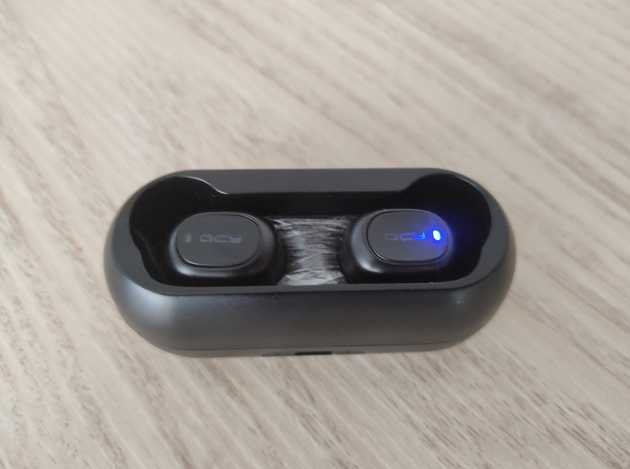
Small shout out to this wonderful person scarbir. If you want to buy new TWS check this site : https://www.scarbir.com/.
Not all combinations of chargers and phones delivers the same results
On Ali you can buy USB tester devices. These are nice 1 purpose devices if you have problems with charger or cables. I have one so I tried to measure different chargers and different cables. It turns out that some cables have either electronic that identifies them as capable of delivering current needed to charge with fast charge OR they are just too thin and will give you slow charge. This can be used for a good purpose too since you might carry around fast charger brick and use different cables to tweak the charging speed.
Some fast chargers with different abilities (protocols) will still charge your phone faster even if phone will not say it is fast charging
Since I have 2 phones with different fast charge protocols I can safely test and say with more capable charger of other protocol your phone will charge faster. It seems phone are checking abilities of charger, some communicate with the charger as USB device, thing are complicated. If you want to read more on this topic QC protocol is described here https://en.wikipedia.org/wiki/Quick_Charge, OnePlus is owned by OPPO so they are using VOOC and SuperVOOC, you can read something more here https://en.wikipedia.org/wiki/Oppo#VOOC.
Here are some pictures of different chargers vs different phones vs different cables. You get the idea. On Xiaomi I have Slovak language so sorry about different labels but on OnePlus you will get what are the numbers representing.
OnePlus Nord 2T 5G with QC charger with original 80W cable :

Here we can see that with same charger the phone can underperform and only take part of the offered current. OnePlus Nord 2T 5G with QC charger with random USB cable :
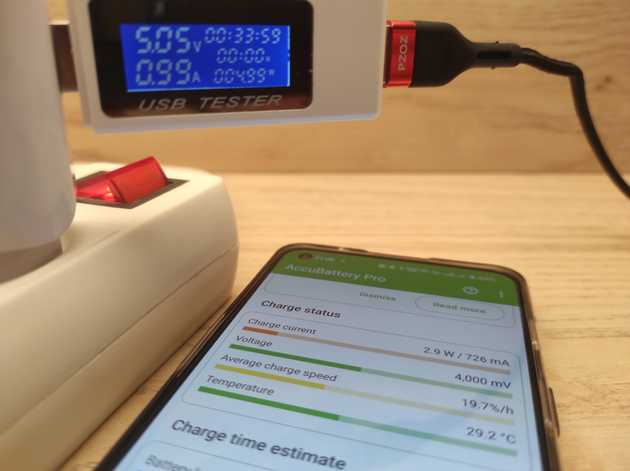
But hey, if we wait for few seconds… Note that there is just “charging” note on the locked display with this setup. OnePlus Nord 2T 5G with QC charger with random USB cable now taking more current :
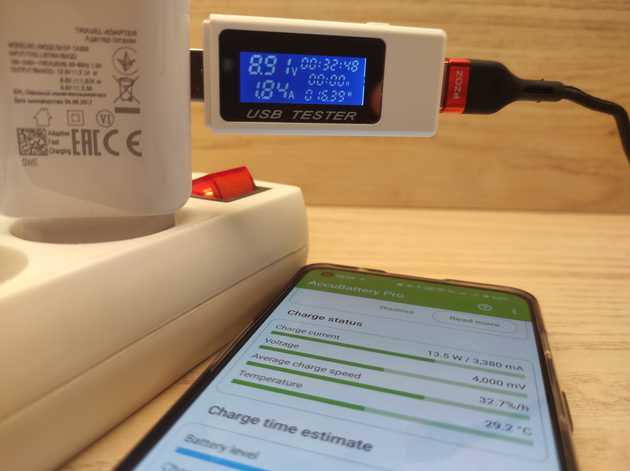
OnePlus Nord 2T 5G with original 80W brick. Please note that 30W is not accurate because app wrongly reports 4000mV and 3000mV and nothing between. Also here we can see that when the battery is charged to 62% the output will never ever get close to declared 80W. This is just maximum number you will get when the battery is nearly empty.
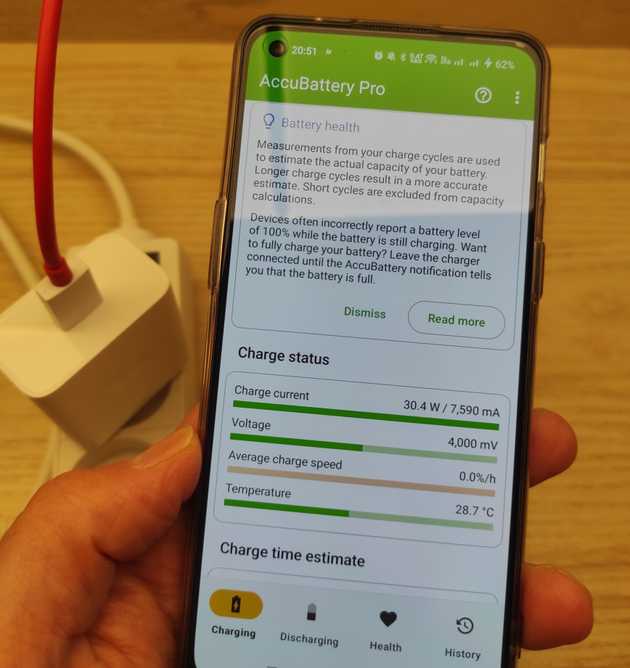
Here we can see the same setup but with some random USB C cable. OnePlus Nord 2T 5G with original 80W brick but without delivered red cable :
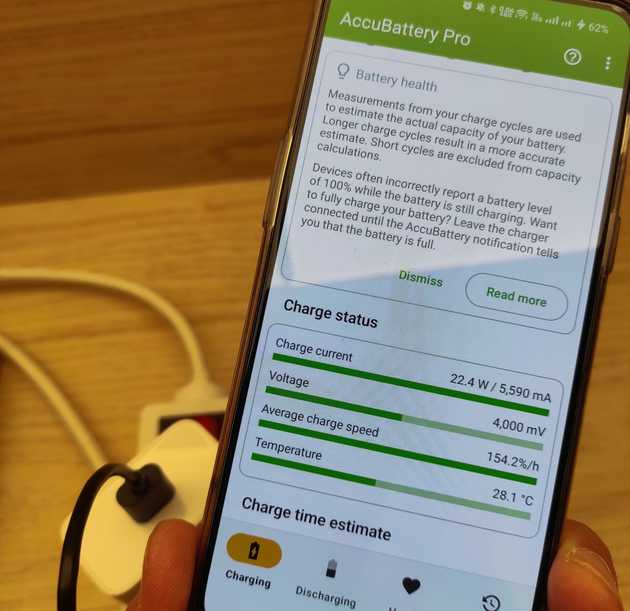
Xiaomi Redmi Note 9 Pro with QC capable charger (not shipped one) and with random cable :

Xiaomi Redmi Note 9 Pro with QC capable charger (not shipped one) and with random cable but less capable to deliver current (wire diameter does really matter) :
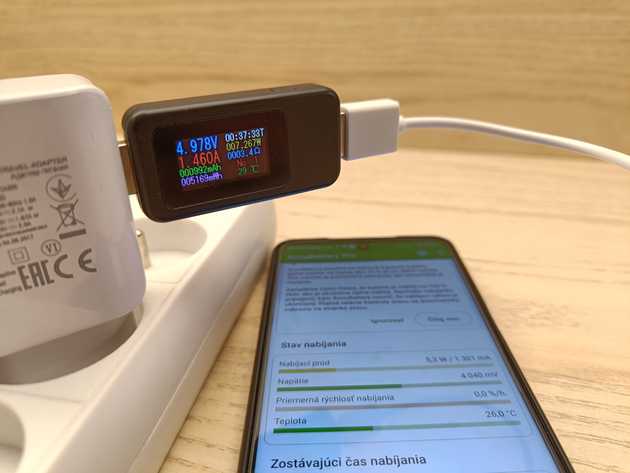
Xiaomi Redmi Note 9 Pro with SuperVOOC 80W charger from OnePlus Nord 2T 5G :
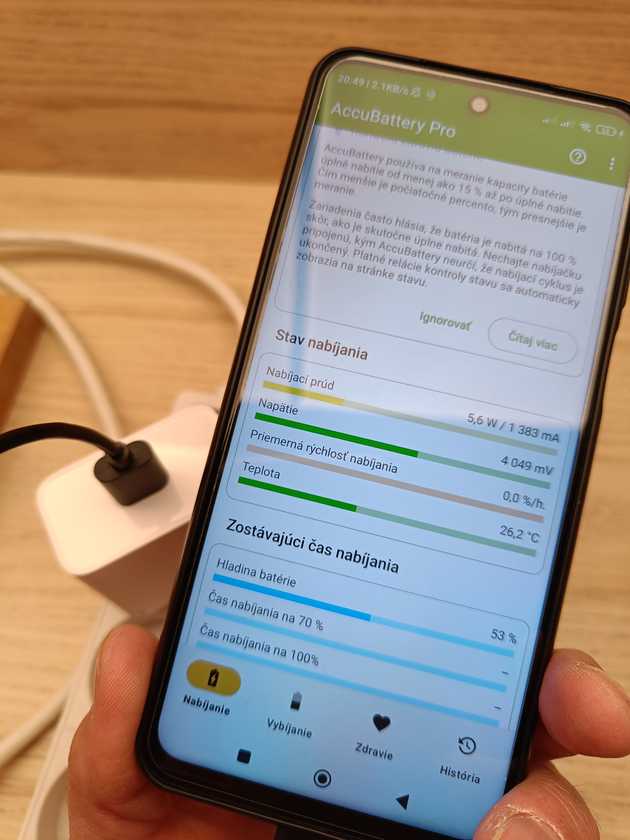
Xiaomi Redmi Note 9 Pro with random 5V and 1,3A charger (from Google Nexus 7 tablet 2013 FHD version):
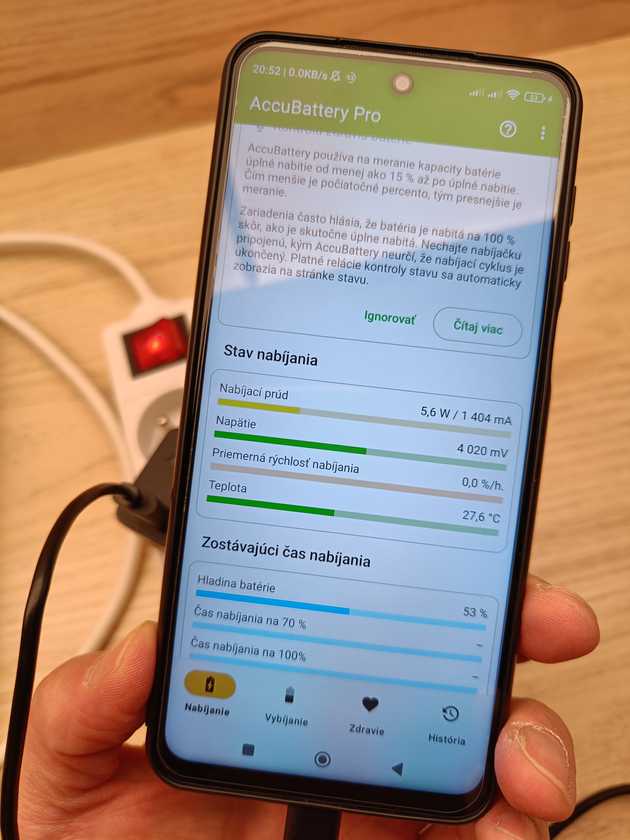
Please note that these pictures are just to illustrate that results with different charger vs cable vs phone will definitely vary and only be measuring what goes into the battery will you be able to find your sweet spot of what you need in your situation.
Some point I forgot? Just drop me an email via this link : https://rostacik.net/contact/.
Hope this helps.